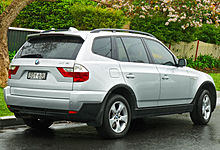What is a transfer box?
The transfer case is a component of the transmission system found in 4 × 4 cars . The name even says what it does: it transfers power from the gearbox to both axles.
That is, while a front-wheel drive or rear-wheel drive car has a direct transmission, the engine sends power to the gearbox, then directly to the wheels by cardan and differential, to 4 × 4, 4WD or AWD cars, somehow it has to be transmitted power to the other side. That’s what the transfer box does.
A gearbox is another transmission that comes immediately after the gearbox. It can be a simple transfer box or with a reducer.
In this transfer box, the 4 × 4 transmission is locked from the button, which travels all the time with front-wheel drive, so that 4 × 4 can also operate in off-road conditions. But the transfer case can be even more complex, computer-controlled, so that it automatically sends power to the front, rear, or both axles.
Cars equipped with all-wheel drive system, compared to one with single-axle traction (front or rear), is more stable while driving and has better dynamic performance because:
- Acceleration is improved because, being distributed on all wheels, the total traction force is higher;
- Thanks to the control of the traction force on each axle, the stability while driving the car is improved.
Compared to a rear-wheel drive car, an xDrive car also has a transfer case, a longitudinal shaft and a differential. The transfer case divides the torque resulting from exiting the gearbox between the two axles of the car.
The transfer boxes are manufactured by Magna Powertrain. From the point of view of the transfer of torque to the front axle, there are two variants of transfer boxes:
- with gears
- with metal chain
The xDrive all-wheel drive system stands out primarily for its simplicity, efficiency but also a very short response time. In addition, in collaboration with the Electronic Stability Control System (DSC), the xDrive system makes a decisive contribution to both active safety and the dynamic performance of the car.
What is xDrive?
BMW xDrive is the brand name for the BMW X1, X3, X4, X5 and X6 all-wheel drive system. It is also optional on Series 1 (2012-present), 2 series (2015-present), Series 3 (2000-present), 4 Series (2014-present), Series 5 (2005-present), Series 6 (2012) -present) and series 7 (2010-present).
Instead of a permanent torque split (which is shown in previous systems), xDrive ensures a variable torque distribution between the front and rear axles, by using a multi-plate wet clutch, located in the gearbox on the output to the front drive shaft.
This configuration allows the xDrive system to modulate the torque split between the front and rear axles, which is normally split at 40:60.
If the ABS / DSC system detects a wheel slip, xDrive can react within a tenth of a second to redistribute up to 100% of engine power on the front or rear axle.
The wet clutch is applied by a high-speed electric servo motor, transforming a cam-shaped drive disc. As the rear drive shaft is engaged at the output of the transmission, the full torque transfer on the front axle can only be achieved if the rear wheels have no traction and both are slippery.
xDrive is connected to ABS and DSC systems. If wheel or steering instability still occurs while xDrive changes or has changed the breaking moment, DSC will break the independent wheels to regain traction and improve directional stability without driver intervention.
The front and rear differences in xDrive vehicles are typically an open differential design, based on the application of the brakes by the DSC system to transfer power from the sliding wheel to the traction wheel.
A variant of the xDrive system is present in the 2015 BMW X1 (F48) model, which is based on a front-wheel drive design and a transversely mounted engine.
In the FWD-derived xDrive version, the front wheels receive 100% of the torque when the xDrive clutch is open, giving it a front bias instead of the regular rear xDrive.
BMW has gradually expanded the availability of xDrive to its full range to better compete with Mercedes-Benz’s Audi and 4Matic quattro, the latter two being widely available in their offerings.
Since the 2010-12 model years, BMW Canada has even stopped offering RWD models if an xDrive counterpart is available for the 5 Series 6 and 7 Series, a major reversal from the 2009 and earlier models, only if the BMW 528i and 535i were available with xDrive.
The change in BMW Canada surprised some observers, as AWD was “the only time Audi had a single chance with Mercedes with a strange mix, the switch to AWD is so strong that many luxury models are now predominantly AWD, although 650 is The first is equally surprising that the Coupe will only be available in the AWD style, if you want a 650 model that only operates on the rear wheels, you will need to choose the ragtop version.
Transfer case components
Compared to a rear-wheel drive car only, a car with an xDrive system also has a transfer case, a longitudinal shaft and a differential. The transfer case divides the torque resulting from exiting the gearbox between the two axles of the car.
The transfer boxes are manufactured by Magna Powertrain. From the point of view of the transfer of torque to the front axle, there are two variants of transfer boxes:
- with gears
- with metal chain
The cogwheel variant (ATC350) is used to equip BMW 1 Series to 7 Series. The metal chain variant (ATC450) is equipped with BMW X models.
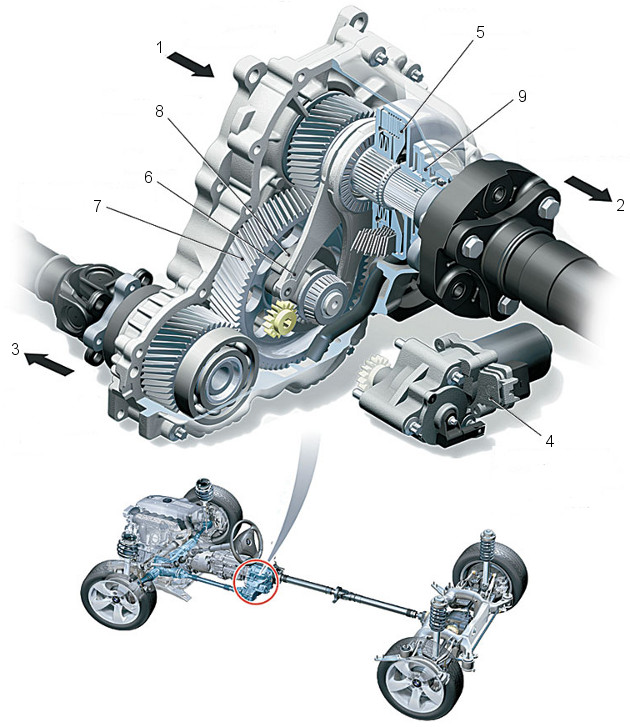
Photo: BMW xDrive All-Wheel Drive System – Gearbox Transmission Components
Source: BMW
- gearbox input
- exit to the rear axle
- exit to the front axle
- electric motor clutch control
- multi-disc clutch
- clutch lever on / off
- intermediate gear
- lever drive cam
- oil pump
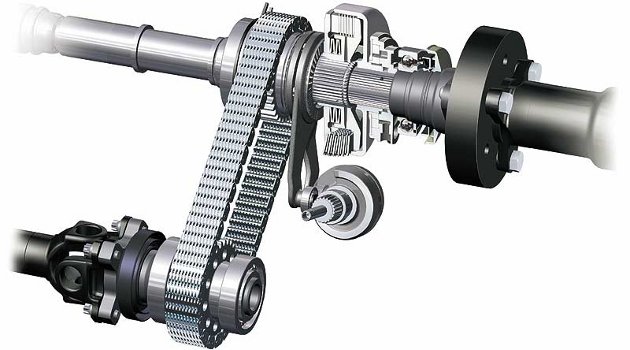
Photo: BMW xDrive All-Wheel Drive – Metal Chain Transfer Case
Source: BMW

Photo: BMW xDrive All-Wheel Drive System – Gearbox Transmission Components
Source: BMW
- gearbox input
- exit to the rear axle
- exit to the front axle
- electric motor clutch control
- multi-disc clutch
- clutch lever on / off
- metal chain
- lever drive cam
xDrive the BMW
It is the marketing name for all-wheel drive, a system found in the BMW X1, X3, X5 and X6 crossover sports. It is also optional on Series 1 (2012-present) Series 3 (2000-present), 4 Series (2014), Series 5 (2005-present), Series 6 (2012-present), and Series 7
About xDrive
Instead of a permanent torque fraction (with which they are equipped with previous systems), xDrive ensures the division of the variable torque between the front and rear axles, using a wet multi-disc clutch located in the gearbox at the front output of the drive shaft .
This configuration allows the xDrive system to modulate the torque break between the front and rear axle, which is normally split at a ratio of 40:60.
If the wheel slip is detected by the ABS / DSC system, xDrive can react within a tenth of a second to redistribute up to 100% of engine power to the front or rear axle. The wet clutch is applied quickly, being electrically driven by the servo motor, a cam-shaped drive disc.
xDrive is connected to ABS and DSC systems. If wheel skidding or steering instability occurs while xDrive is on or off, the DSC will brake the wheels independently to regain traction and improve steering stability without driver intervention.
The front and rear differentials in xDrive vehicles are an open differential design, relying on the DSC system to transfer power from the sliding wheel to the traction wheel.
For BMW, the year 1985 marked the beginning of the use of all-wheel drive systems. The first all-wheel drive car was a BMW 3 Series. The system used a permanent distribution transfer case: 37% of the traction force on the front axle and 63% on the rear axle.
The modern all-wheel drive system used by BMW, called xDrive , fitted the first BMW X5 car in 2004. This system is currently present in the basic equipment for the X1, X3, X4, X5 and X6 models and is offered as an option for the rest of the models.
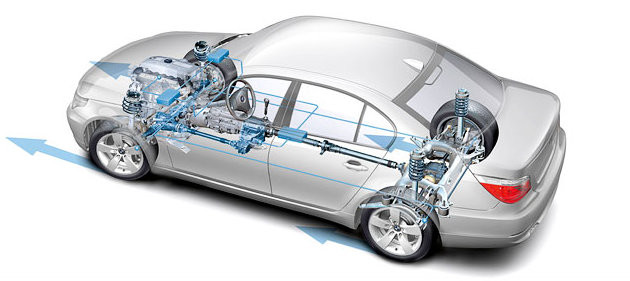
Photo: BMW with xDrive all-wheel drive system
Source: BMW
An all-wheel drive car, compared to a single-axle traction system (front or rear), is more stable while driving and has better dynamic performance.The acceleration is improved because, being distributed on all wheels, the total traction force is higher.
Also, thanks to the control of the traction force on each axle, the stability during the movement of the car is improved.
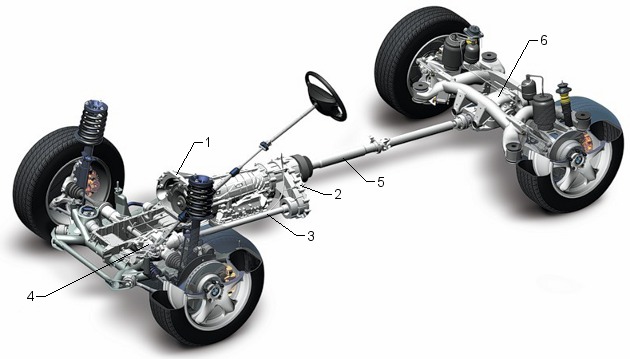
Photo: xDrive all-wheel drive system
Source: BMW
- gearbox (automatic)
- transfer box
- longitudinal shaft (towards the front axle)
- differential face
- longitudinal shaft (towards the rear axle)
- rear differential
Compared to a rear-wheel drive car, an xDrive car also has a transfer case (2), a longitudinal shaft (3) and a differential (4). The transfer case divides the torque resulting from exiting the gearbox between the two axles of the car.
The transfer boxes are manufactured by Magna Powertrain. From the point of view of the transfer of torque to the front axle, there are two variants of transfer boxes:
- with gears
- with metal chain
The sprocket version (ATC350) is used to equip BMW 1 Series to 7 Series. The metal chain variant (ATC450) is equipped with BMW X models.

Photo: BMW xDrive All-Wheel Drive System – Gearbox Transmission Components
Source: BMW
- gearbox input
- exit to the rear axle
- exit to the front axle
- electric motor clutch control
- multi-disc clutch
- clutch lever on / off
- intermediate gear
- lever drive cam
- oil pump

Photo: BMW xDrive All-Wheel Drive – Metal Chain Transfer Case
Source: BMW

Photo: BMW xDrive All-Wheel Drive System – Gearbox Transmission Components
Source: BMW
- gearbox input
- exit to the rear axle
- exit to the front axle
- electric motor clutch control
- multi-disc clutch
- clutch lever on / off
- metal chain
- lever drive cam
The principle of operation is relatively simple and applies to both versions of transfer cases. When the clutch is fully open all torque is transmitted to the rear axle.
When the clutch is completely closed and both axles have the same load, the torque is transmitted 50:50 between the two axles.
In case of acceleration, starting from the spot, even if the clutch of the transfer case is completely closed, the rear axle transmits more torque because it is loaded more dynamically.
The transfer of engine torque between the two axles is done automatically depending on the available grip on each axle.
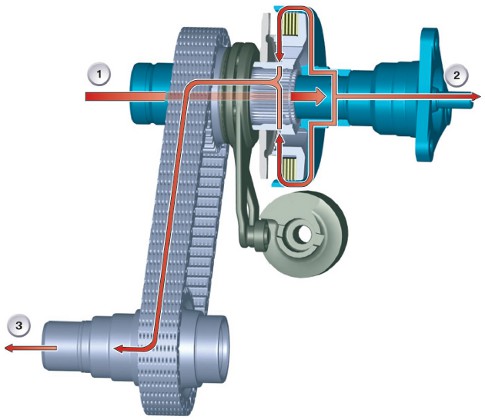
Photo: BMW xDrive all-wheel drive system – torque transfer between the two axles
Source: BMW
- torque input (from gearbox)
- exit to the rear axle
- exit to the front axle
If the clutch is completely closed, the torque is distributed between the two axles according to the adhesion of each axle. When passing over a low adhesion surface (eg ice) the torque transfer between the two axles is done as follows:
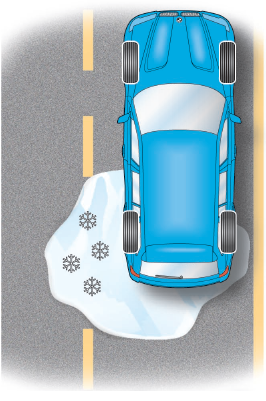
Photo: Moving the car over a low grip surface
Source: BMW
| Stage | Front deck couple | Rear axle torque |
| Front axle wheels are on ice (low grip) and rear axle wheels are on asphalt (high grip) | Very low, close to zero | Very large, it can take up all the available engine torque, depending on the available grip |
| Both wheels are on asphalt | About half the torque, depending on available axle load / grip | About half the torque, depending on available axle load / grip |
| The front axle wheels are on asphalt and the rear axle wheels are on ice | Very large, it can take up all the available engine torque, depending on the available grip | Very low, close to zero |
The transfer of torque for traction between the two axles is done almost instantly, without being notified by the driver or passengers.
Closing and opening the clutch is done with the help of a direct current electric motor. The engine is equipped with a Hall effect position sensor that allows the electronic control mode (TCCU) to calculate the position of the clutch and thus the percentage of torque transferred to the front axle.
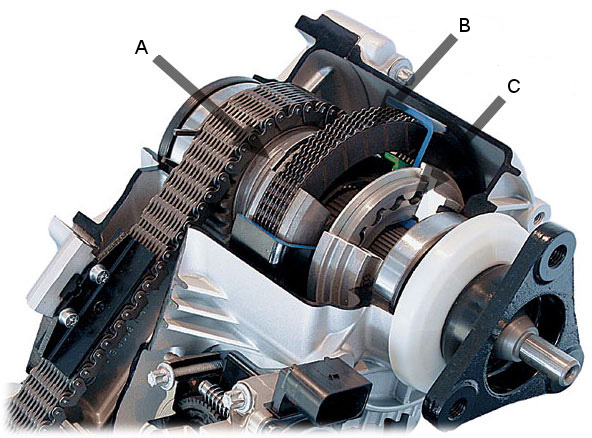
Photo: BMW xDrive all-wheel drive system – transfer case detail
Source: BMW
A – levers
B – multi-disc clutch
C – oil pump
The DC motor rotor is equipped with a cam whose profile acts on two levers. The two levers are separated by a set of metal balls which allows them to rotate relatively.
By rotating the balls move on an inclined profile which forces the levers to move axially and press on the multi-disc clutch. That said, the two levers have a compound motion: one rotational, imposed by the cam, and the second axial due to the balls.

Photo: BMW xDrive all-wheel drive system – multi-disc clutch coupling / disengagement mechanism
Source: BMW
The electronic control mode of the transfer case receives a torque control from the electronic stability control system.
The advantages of the variable torque distribution between the front and rear axle are:
- optimizing the grip between the two axles while making a turn
- improving the stability of the car while driving by controlling the torque between the two axles, requiring the intervention of the DSC mode on the braking system only in critical conditions.
The car’s stability control system (DSC) controls the torque transferred to the front axle. If the DSC system is disabled, the electronic transfer box control module (TCCU) remains active and uses its own control algorithms to optimize torque distribution.
The xDrive system contributes significantly to the stability of the car during cornering. By controlling the torque between the front and rear axles, the car’s oversteer and understeer trends are corrected.
The DSC system continuously monitors the car’s dynamics using the wheel speed sensors, the longitudinal acceleration sensor and the turn sensor.
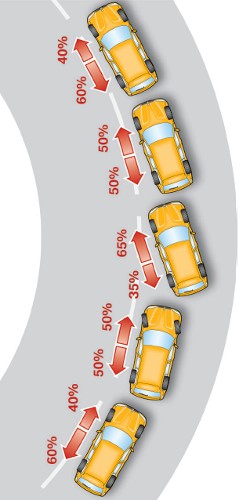 | 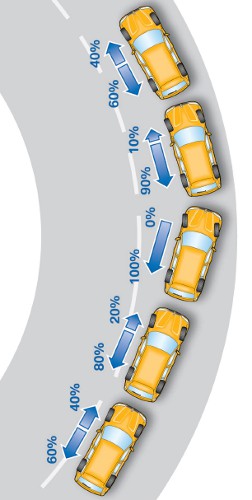 |
| Photo: BMW xDrive all-wheel drive system – oversteer correction Source: BMW | Photo: BMW xDrive all-wheel drive system – understeer correction Source: BMW |
Photo: BMW xDrive all-wheel drive system – correcting the car’s oversteer and understeer trends
Source: BMW
In case of oversteer, the rear axle loses grip. The transfer case clutch closes completely allowing the front axle to pick up as much of the available torque as possible, thus correcting the oversteer trend.
If the car overturns, the clutch opens completely and all available torque is transferred to the rear axle. Rear axle-only cars tend to be oversteer and thus compensate for understeer.
BMW’s xDrive all-wheel drive system stands out for its simplicity, efficiency and very short response time. Combined with the Electronic Stability Control System (DSC), the xDrive system contributes decisively to the active safety and dynamic performance of the car.
Cars equipped with xDrive
xDrive can be installed on X1, X3 and is a standard equipment on X5 and X6 sport crossover vehicles. It is also optional on Series 3 (2003-present for sedan, 2007-2013 for coupes), 4 Series (2014), Series 5 (2005-present), Series 6 (2012-present for coupe and Grand Coupe) , and 7 Series (2010-present).
BMW has gradually expanded the availability of xDrive across the range to compete with the Audi quattro and Mercedes-Benz s 4Matic, the latter two of which are widely available.
For the 2010-2012 models, BMW Canada has stopped offering RWD ornaments if an xDrive part is available for the 5 Series, 6 Series, and 7 Series, a major change from the 2009 model and in the previous case only the BMW 528i and 535i were available with xDrive.
BMW Canada switch surprised some observers, because AWD was “once the only scope of Audi, with a few imported Mercedes, the switch to AWD is so powerful that many luxury models are now predominant with AWD, however that the 650 is BMW’s first high-end sports coupe.
Even more surprising is that the Coupe will only be available in AWD form. If you want a 650 that only powers the rear wheels, you’ll need to opt for the ragtop version. ”
xDrive was introduced in 2003 with the new X3 and the old BMW 3 Series (E46).
The first application of xDrive on BMW V8-powered cars (as opposed to sports vehicles) was in 2010. BMW 750i xDrive (F01), 2010 550i xDrive Gran Turismo (F07), and since 2011 BMW 550i xDrive (F10).
xDrive has been used for the first time since the BMW M, vehicles since 2010 BMW X5 M and X6 M. BMW has also confirmed that they are looking to produce a BMW M5 with xDrive, although availability has not been confirmed.
Dynamic performance control
Dynamic Performance Control torque system Vectoring BMW works in unison with xDrive all-wheel drive and Dynamic Stability Control.
DPC is a transmission and chassis control system, which works to regulate traction and especially to correct understeer by actively spreading the driving forces on the rear axle.
The torque is split not only between the front and rear wheels (xDrive), but also from side to side in the rear for better agility and added stability (via the DPC rear axle).
DPC operates at all speeds and driving standards, not just during heavy turns, in order to drive the car.
DPC also interfaces with the DSC initially trying to correct the vehicle’s trajectory by using torque vectoring which leads to smooth cornering, while the DSC itself only reduces engine power and applies the brakes to drive the vehicle.
The DPC differential has clutch packs on both sides of the output, which are driven by an electric motor. The clutch package activates a planetary gear system that causes a wheel to overturn.
A conventional control system will use the brakes to reduce the speed of the skating wheel (which is the least traction) and reduce engine power. This leads to increased brake wear and slower than optimal progress.
By contrast, the DPC system accelerates the slow wheel (the one with the most traction) in order to maintain stability when needed.
For example, while the outer wheel rotation is oversteer it will provide greater acceleration, using the advantage of traction by dynamically loading the outer wheel in corners. Meanwhile, in a situation of oversteer, the inner wheel that is oversteer regains its traction balance.
The first application of the DPC was introduced on the BMW X6, which began production in 2008 as an inv2009 model, where this is standard equipment.
One test found that “the X6 feels hundreds of pounds lighter on its feet than the X5 [without DPC]”, so it will benefit from DPC, even though both vehicles have similar chassis sizes. The BMW X5 M high-performance variant also has DPC standard. [4]
4WD predecessor system
Before the existence of xDrive, BMW offered 4WD as an option in the 1980s for the 3 Series and 5 Series. The system had a planetary center differential with a permanent 38-62 (front-rear), split torque.
Both the center and the rear differential had a viscous lock that acted automatically if the slip occurred (one shaft rotated at a significantly different speed than the other). The front differential did not have any locks of any kind.
4WD was again offered by the X5 in 2001 series 3. The system was similar to the previous system except for the locks. Instead, the sliding wheels would be braked with the DSC system, helping the transfer power from the traction wheels.
BMW history
The BMW X3 is a luxury compact crossover model sold by German carmaker BMW since 2003. Based on the BMW 3 Series platform, and now in its second generation, BMW is selling the sport crossover, described as the X-Series vehicle.
The first generation X3 was designed by BMW in conjunction with Magna Steyr in Graz, Austria, which manufactured all X3 models under contract with BMW. BMW manufactured the second generation of X3s at its Spartanburg factory in South Carolina, USA.
First generation (2003–2010)
As a predecessor to the X3, BMW unveiled xActivity, the concept car, at the 2003 Detroit Auto Showroom based on the 3 Series platform and promoted a folding hood with longitudinal bars connected to the rear of the car on both sides. creating a distinct profile.
The X3 premiered in September 2003 at the Frankfurt Motor Show, sharing the rear suspension with the E46 330xi and using the all-wheel drive system called the xDrive.
The system used electronic control of the clutch discs to achieve infinite adjustment, variable acceleration distribution from front axle to rear axle with a capacity of up to 100% of engine speed on both axles. The X3 is designed to combine the agility of a compact model with the driving experience of an X5.
BMW improved the model in 2005 and changed it in 2007, changing the housing, engine and suspension.
The 3.03 X3 won the 2005 Canadian Sport Utility Car of the Year award.
Second generation (2010 – present)
The F25 platform is the second generation of the BMW X3 launched in 2010, a model for 2011.
Production of this generation was moved from the BMW factory in Austria to the Spartanburg factory in the United States, where the X5 and X6 models are produced. The F25 is almost as big as the original X5 E53.
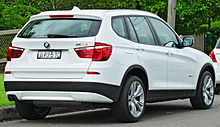
For 2011, the X3 model on the F25 platform is only available in the United States, only with the 3-liter 6-cylinder petrol engine, normally equipped with a double turbine.
All vehicles in the United States come with an 8-speed automatic transmission.
In other markets there are various combinations of engines including the 2-liter and the 3-liter diesel with 8-speed automatic transmission or a 6-speed manual gearbox. All X3s are equipped with the BMW xDrive all-wheel drive system.
X3 Cross Country
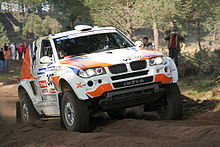 The X3 Cross Country, also known as the X3 CC, is an X3 ready for rally competition. [6] [7] It features a 2.9-liter inline-6 diesel engine (M57TU2D30 engine disassembled and destroyed from 3.0 liters to 2.9 liters), twin-turbo diesel engine. [8]
The X3 Cross Country, also known as the X3 CC, is an X3 ready for rally competition. [6] [7] It features a 2.9-liter inline-6 diesel engine (M57TU2D30 engine disassembled and destroyed from 3.0 liters to 2.9 liters), twin-turbo diesel engine. [8]
The X3 Cross Country, also known as the X3 CC, is an X3 equipped for rallying. It is equipped with a 2.9-liter twin-turbine diesel engine.
Ubydeal – The solution for the transfer box
Ubydeal offers quality solutions for transfer case failures at affordable prices. We repair and recondition the transfer boxes and also change the transfer box oil . If you need one of these services do not hesitate to contact us +40 742 140 476
You may also be interested in:



